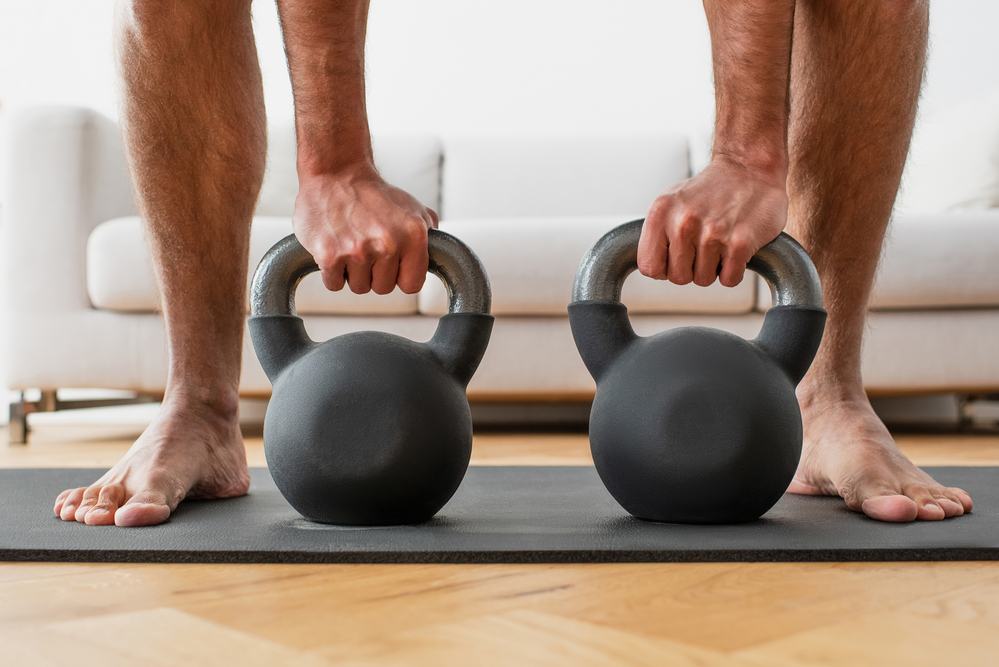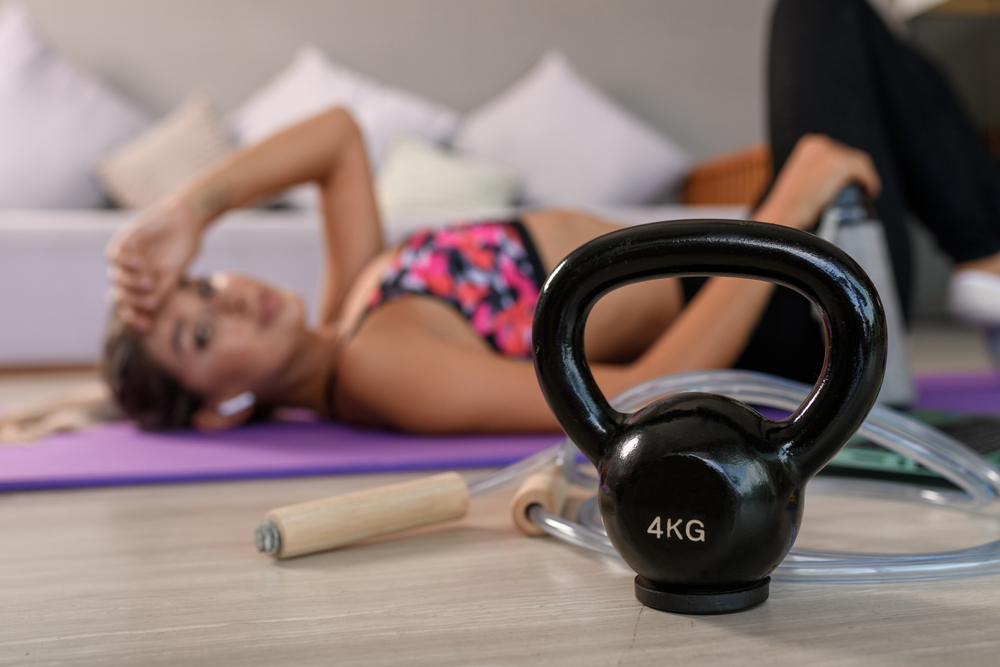Kettlebells can be effective for total body training in tight spaces.
In this guide we’ll be offering some considerations before using kettlebells at home, along with some sensible examples of how to put the exercises together.

Safety considerations
Flooring
Kettlebell training is best performed barefoot. Make sure the surface you choose has adequate grip. If the floor is slippery underfoot – laminate wood flooring for instance – you can use a grippy yoga mat to train on.
In the absence of a padded foam mat, we would set the weights down on a cushion between sets to reduce the risk of damaging the floor.
If you have a garden with a grassed area, grass is great for training with kettlebells. Unless of course it’s raining and muddy.
It feels very satisfying to chuck the bells down to the ground when you’ve finished a hard set.
Don’t do this if you don’t want dents in your grass, obviously.
Ceiling height
Depending on your weight with relation to the ceiling, overhead movements may need to be modified.
You may need to ditch snatches, and swap out standing pressing for kneeling or seated variations.
Pushing boundaries
When training at home, dropping a weight can create expensive damage. You don’t want to crack tiles or flooring. Always use a weight that is within your capabilities.
If you’re serious about your training and want to push boundaries at home, it is wise to invest in some interlocking foam tiles. Train where a mistake won’t cost you – like a garage on the ground floor.
Surrounding objects
Stay well away from anything breakable – televisions, computers, glass surfaces, tiles.
You would think this would be obvious, and I considered not even mentioning it. Then I googled “kettlebell accidents” and found enough fail compilations to change my mind.
Pets and small children
Households aren’t dedicated exercise spaces. When working with ballistic movements like the swing that demand your concentration, be sure that no curious pets or children are able to wander into the line of fire.
If you have pets or small children and aren’t able to get any privacy, be sure to position your workout space so that you can see approaching at all times.
Warming up
The great thing about kettlebells is that because the weight isn’t too heavy, you can warm up reasonably quickly then get down to business.
Here are two great kettlebell movements you can use to warm up for your training.
1. Halos
The halo is a simple shoulder mobility drill. Hold the kettlebell upside down by the horns at eye level. “Orbit” the bell around the head in smooth circles, keeping the bell at eye level throughout.
2. The Turkish get-up (TGU) is a great movement to open up your hips, shoulders and mid-back.
At heavier weights, the TGU is a challenging exercise. At lighter weights, it’s a great warm-up movement that covers multiple joints.
How to store kettlebells at home
Kettlebells are robust and can be stored almost anywhere inside your house without damage.
Because kettlebells are made of iron or steel, you can expect the underside of the kettlebell to rust over time. To protect your flooring, it makes sense to store them on some matting, or a surface you are not concerned about staining.
Some types of kettlebells can be stored outside too, with minimal impact to them. I stored three Dragondoor (Hardstyle) bells outside a farm building for a decade. If anything, the ever-so-slight weathering made for a pleasant texture on the handle. Those three bells are still in active daily use today.
You cannot store competition steel bells outside. The bare steel handle would rust. Because rust is a tetanus risk, you would need to remove the rust before you could safely use them again.
How to make kettlebells at home
If you want to train with kettlebells, it is worth investing in a good tool.
But if you want to go the DIY route, we’ve got you covered in our ultimate guide of kettlebell alternatives.
Example workouts
The number of workout options even with just a single kettlebell is bewildering. Here are some examples of tested workouts that are brief and effective.
While we won’t be covering how to execute the most common movements here, we will be adding notes on some less well-known exercises.

Example chest workout at home with kettlebells
Kettlebells aren’t ideal for working horizontal pressing patterns, but they can get the job done.
Many people pair bodyweight movements like push-ups with their kettlebell training. What if you can’t do a push-up, though? The below options can help you.
If you have a bench, you can bench press them in a similar fashion to dumbbells. Use a clean to rack the bells on the chest, sit on the bench, lay down and press. Keep the wrists straight throughout.
Most people select kettlebells for home training because of the small footprint, and are unwilling to create space for a dedicated exercise bench. If that’s your situation, these variations are for you:
First, you can floor press with kettlebells. It can be tricky to get the bells into the right position, so it’s safer on your shoulders to perform this movement one bell at a time.
Lay flat on your back and press the bell with straight wrists. Take care to lightly touch your tricep on the floor each time, as opposed to landing on your elbow.
The second variation is the kettlebell bridge press. Laying on your back as you would for the floor press, bring your knees up and plant your feet close to your buttocks.
Squeeze your buttocks and bridge up high with the hips. Now you have an extended range of motion to press the kettlebells with.
Finally, you may still be able to modify the pushup to include in your home training! I am not a fan of pushups on the knees, but I do use partial ranges extensively in my training.
By setting up with your chest over a stack of books, you can train a partial range of motion, and decrease the stack over time.
A simple example of a chest superset including kettlebells:
- KB floor press 12-15 reps
- Partial push-up 10-20 reps
Repeat for 3-6 rounds.
Example CrossFit workout at home with kettlebells
Because CrossFit doesn’t adhere to any structure, you can pretty much string any exercises together and call it a CrossFit workout.
If you were training for CrossFit, you would need to be familiar with the American Swing. In this exercise, the implement swings between the legs and is then raised over the top of the head. The arms are straight throughout.
Example workout:
- 12 minutes
- 14 American swings
- 7 burpees
Repeat for as many rounds as you can within the allocated time limit.
Example leg workout at home with kettlebells
Many kettlebell movements work the lower body thoroughly. Your bread and butter here is going to be some combination of swings and goblet squats.
Here’s a simple and reasonable superset using swings (SW) and goblet squats (GS) that will cover the bases:
SW 10 10 10 10 10 10 10 10 10 10
GS 10 9 8 7 6 5 4 3 2 1
- 10 swings
- 10 goblet squats
- 10 swings
- 9 goblet squats
- 10 swings
- 8 goblet squats
- 10 swings
- 7 goblet squats
- 10 swings
- 6 goblet squats
- 10 swings
- 5 goblet squats
- 10 swings
- 4 goblet squats
- 10 swings
- 3 goblet squats
- 10 swings
- 2 goblet squats
- 10 swings
- 1 goblet squat
That’s 100 swings and 55 goblet squats. Simple but effective!
Example arm workout at home with kettlebells
Working the arms directly with kettlebells can be a bit awkward. Dumbbells generally lend themselves better to elbow flexing and extending.
Kettlebell pressing movements, which predominantly work the shoulders and tricpes, are well documented. Less well documented are bicep movements adapted for the kettlebell!
Here are some curl variations you can use:
Crush curl – press the bell between your cupped palms and crush the weight as you curl.
Kettlebell hammer curl – hold the handle vertically and curl the weight with the bell facing away from you. This is grip intensive and the displacement of the weight from your hand will be challenging.
Reverse curl – these are great for elbow health. Hold the handle with the palm facing down and perform curls.
Goblet squat curl – this curious movement can also improve your hip and thoracic mobility. You have three choices of grip: holding the bell by the horns, holding the bell by the horns upside down as you would in a KB halo, or in a crush curl grip.
Sit into the bottom of a goblet squat, anchor your elbows against the inside of your thighs, and use the elbow as a lever to “crank” the mid back open while you perform curls.
Short and simple kettlebell arm workout:
One arm kettlebell clean and press
- 1 clean, 3 presses
- 5 rounds per arm
Kettlebell hammer curl
- 4 sets of 15 reps
Example full body workout at home with kettlebells
Here’s a reasonable kettlebell workout that will cover all the bases in one go.
A) Turkish get-up
3 reps per side
B) 20 Two handed swings
4 rounds
C) Double kettlebell clean and press
One clean and 8 presses
3 rounds
D1) Goblet squat
8 reps
D2) Goblet squat curl
After 8th rep, stay in bottom of goblet squat and perform 10-12 curls
3 rounds
E) Kettlebell bridge press
4 sets of 15 reps
Optional finisher if space provides:
F) Farmers walk carrying one or two heavy kettlebells.
When carrying weights in a small space, you can walk in a figure 8 pattern for continuous movement. If your space is too small, you can walk outside. If you’re in a block of flats, use the stairs for an extra stimulus!
Sources
I’ve been in the fitness and strength training industry for nearly a decade. In that time, I’ve gained 30 pounds of muscle, written hundreds of articles, and reviewed dozens of fitness supplements. As for my educational background, I’m a currently studying for my Active IQ Level 3 Diploma in Personal Training.

